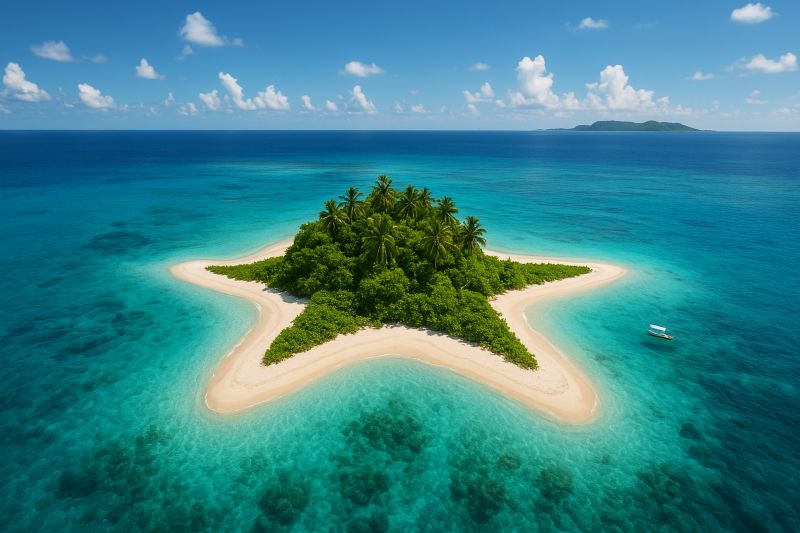The Philippines’ Hidden Starfish Island Booming Tourism and Instagram’s Influence Could Alter Its Future, What Lies Ahead?
Explore the fragile ecosystem of Starfish Island in Honda Bay, Puerto Princesa, and learn how responsible tourism can protect this unique destination for future generations.
Starfish Island, located a mere 30 minutes from Puerto Princesa in Honda Bay, is a rare and unspoiled haven, home to the remarkable Protoreaster nodosus, or chocolate chip starfish. The island has been a natural sanctuary for these starfish and various marine life, thanks to its protected environment. However, the island’s pristine ecosystem is increasingly under threat as tourism in the surrounding areas, especially in Palawan, grows. While other popular tourist destinations, such as El Nido, have become overwhelmed by millions of visitors annually, Starfish Island has been able to maintain its peace and serenity through effective conservation measures. Sadly, the growing influence of social media, with its obsession with perfect travel photos, is now posing a serious risk to the balance that the local community has worked so hard to preserve.
The Growing Influence of Social Media on Island Conservation
In recent years, the growing influence of social media has fundamentally changed how people approach travel. Many tourists, driven by the desire to capture that perfect Instagram moment, inadvertently disturb delicate ecosystems. Locals, particularly tour guides who have spent years studying the island’s natural surroundings, have raised concerns over this trend. For example, it has been reported that visitors often touch the starfish in pursuit of the perfect photograph, unaware that these actions can be harmful. Though the tourists likely do not intend to harm the environment, the damage is real—particularly during the starfish mating season, which runs from February to March, when the population of starfish in the shallow waters peaks and their vulnerability increases.
Why Starfish Are Particularly Vulnerable to Human Interaction
The chocolate chip starfish species found on Starfish Island are particularly sensitive to human interaction due to their unique biology. As local guides explain, starfish breathe through their skin, meaning even a brief exposure to air—such as the time it takes to snap a photo—can cause them considerable stress. The cumulative impact of hundreds of tourists interacting with the starfish in this manner leads to increased mortality rates, putting the population at risk. This problem isn’t theoretical; similar species have already been driven to extinction in places like Guam because of overharvesting and human interference. The need for continued conservation efforts in Honda Bay has thus become even more critical to ensure that the chocolate chip starfish do not suffer the same fate.
The Hidden Mortality Rate and Its Consequences
During peak tourist seasons, it’s estimated that between 5% to 10% of the starfish exhibit signs of stress due to being handled. These signs include pale skin, sluggish movements, and a higher vulnerability to predators because the starfish become weaker and less able to defend themselves. In Honda Bay’s shallow waters, these stress symptoms are more visible, which draws attention to the damage caused by careless tourism. This transparency underscores the importance of responsible tourism. While the responsibility lies primarily with the guides, it is vital for visitors to understand their role in protecting the environment. To ensure the continued health of the ecosystem, all tourists must respect the no-touch rule for the starfish.
The Hidden Advantage of Honda Bay: Jellyfish-Free Waters
One of the overlooked benefits of visiting Honda Bay is its jellyfish-free environment. Unlike other well-known destinations in Palawan, such as El Nido, which can suffer from seasonal jellyfish blooms, particularly during the monsoon season, Starfish Island benefits from a unique geographical position that keeps the waters clear of jellyfish. This makes the bay an attractive destination for snorkelers and divers, as they can enjoy a safer and more comfortable underwater experience. The added bonus of affordable pricing—only $30 for a full-day tour—makes Honda Bay an appealing option for those looking for an alternative to more expensive spots like El Nido. For eco-conscious travelers seeking a peaceful and less crowded experience, Honda Bay is a perfect choice.
The Ideal Time to Visit: February to March
The best time to visit Starfish Island is during the starfish mating season, which takes place from February to March. During this period, the Protoreaster nodosus gathers in particularly high concentrations in the shallow waters of Honda Bay, providing visitors with a natural spectacle. This peak season, however, brings with it an increase in tourist activity. To ensure that the island’s ecosystem does not become overwhelmed, tour operators strictly limit the number of visitors to 50 to 100 per day. This careful management demonstrates the importance of sustainable tourism. By controlling the number of tourists allowed to visit during this peak season, Starfish Island can maintain its pristine environment while still offering visitors a memorable experience.
The Need for Responsible Snorkeling in Honda Bay
When planning a trip to Honda Bay, it is essential to book tours with eco-certified operators who prioritize environmental sustainability. These operators enforce the no-touch rule for starfish and other marine life, ensuring that the delicate ecosystem is not disturbed. In addition to enforcing these rules, eco-certified guides also provide educational briefings about the local marine life, helping tourists understand the importance of preserving the environment. Though the cost of tours is generally $30, booking with certified operators ensures that the funds directly benefit local conservation efforts, helping to sustain the island’s long-term health and viability.
Spreading the Tourism Load Across Honda Bay
To ensure that Starfish Island does not become overrun with tourists, local authorities have implemented a strategy of spreading tourism across nearby islands such as Cowrie Island and Luli Island. These islands, while still beautiful, do not face the same ecological pressures as Starfish Island, making them better suited for heavier tourist traffic. By encouraging visitors to explore other islands in Honda Bay, the local authorities are able to reduce the burden on Starfish Island. This strategy of spreading tourism across multiple destinations ensures that the natural beauty of the region is preserved while still offering visitors a wide variety of experiences. It highlights a growing trend in sustainable travel, where the environmental burden of tourism is shared by several locations, helping each one to maintain its charm and integrity.
Guidelines for Responsible Travel to Starfish Island
For those planning to visit Starfish Island, there are a few essential guidelines to follow in order to ensure that the island remains protected for future generations:
- Always respect the no-touch rule for starfish to minimize harm to the ecosystem.
- Choose eco-certified operators for your tours to ensure compliance with environmental guidelines.
- Plan your visit during the dry season (October to May) to ensure optimal weather and visibility.
- Opt for morning tours (between 8 am and 11 am) to enjoy calm waters and better underwater visibility, while avoiding crowds.
How to Reach Starfish Island
Getting to Starfish Island is straightforward: travelers can take a 45-minute boat ride from Puerto Princesa to Honda Bay, where the island is located. It is highly recommended to book tours with eco-certified operators, as they ensure that all conservation protocols are followed, and the trip benefits the local community by supporting sustainable tourism.
The Role of Sustainable Tourism in Protecting Starfish Island
The long-term future of Starfish Island heavily relies on the actions of its visitors. As tourism continues to increase in Palawan, it is essential to maintain a balance between economic growth and environmental preservation. Visitors must adhere to the guidelines set by local authorities to ensure that the island remains pristine. By supporting eco-conscious operators and engaging in responsible tourism, travelers can contribute to preserving Starfish Island as a sanctuary for marine life. This model of sustainable tourism, which emphasizes conservation and education, can serve as a blueprint for other destinations worldwide, demonstrating that it is possible to enjoy natural wonders without compromising their long-term health.
Global Implications for the Travel Industry and Travelers
The growing popularity of eco-tourism presents a challenge and opportunity for the travel industry. As destinations like Starfish Island face increasing pressure from tourism, the travel industry must adapt to the rising demand for authentic, low-impact experiences. This shift signifies that travel operators and tourists alike need to become more conscious of their environmental footprint and make informed decisions about where and how they travel.
For travelers, the lesson is clear: enjoyment of a destination should never come at the cost of its environmental health. With the increasing popularity of eco-tourism, it is crucial that travelers choose destinations and experiences that prioritize sustainability and conservation. Destinations like Starfish Island provide the opportunity to learn about the impact of tourism on local ecosystems and understand how responsible travel can ensure the survival of these natural wonders.
Preserving Starfish Island for Future Generations
The future of Starfish Island depends on the responsibility of its visitors. If travelers respect the rules, adhere to sustainability practices, and support eco-friendly operators, this paradise can remain preserved for future generations to enjoy. Starfish Island serves as an example of how responsible tourism can protect and preserve natural beauty while still allowing visitors to experience it. As Palawan continues to grow as a popular destination, the travel industry must prioritize sustainable practices to protect these irreplaceable natural treasures. Through careful management and mutual respect for the environment, places like Starfish Island can continue to thrive, even amidst the growing pressures of global tourism.
The post The Philippines’ Hidden Starfish Island Booming Tourism and Instagram’s Influence Could Alter Its Future, What Lies Ahead? appeared first on Travel and Tour World


Comments and Responses
Please login. Only community members can comment.